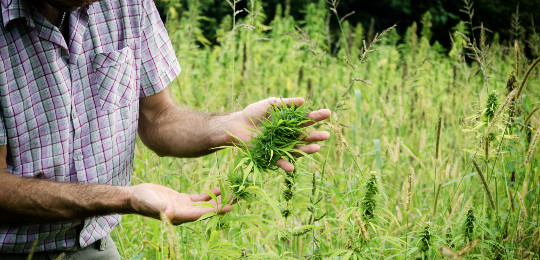
To review the County's Industrial Hemp Ordinance Public Review Draft, visit the County Agricultural Commissioner's website here.
San Luis Obispo County Farm Bureau's comments on the Industrial Hemp Ordinance Public Review Draft are copied below.
December 19, 2019
San Luis Obispo County
Department of Planning and Building
Attn: Kip Morais
976 Osos Street Room 200
San Luis Obispo, CA 93408
Submitted by email to pl_LongRangeShared@co.slo.ca.us
Re: County of San Luis Obispo Industrial Hemp Ordinance Public Review Draft
San Luis Obispo County Farm Bureau represents all of the farmers, ranchers and agribusinesses that make up our $2.5 billion-dollar county agricultural economy. Like all policy issues, our positions on industrial hemp must reflect our members’ diverse perspectives. Our 800 members include hemp and cannabis growers, retailers, rural residents opposed to all cannabis, wine grape growers, and farmers raising other commodities. Since the Urgency Ordinance was passed on June 18, 2019, Farm Bureau has tried to find common ground between stakeholders on this difficult issue both within our membership and through the Agricultural Liaison Advisory Board. Our comments here are to help guide County staff, Planning Commissioners and Supervisors to fairly understand industrial hemp issues and to make this ordinance workable for San Luis Obispo County.
Our principal objective is to preserve our freedom to farm, not to farm any one particular crop. We must prioritize protecting our largest commodity (wine grapes), while being mindful of how any protections enacted today could jeopardize all farmers down the road. We also have a responsibility to attract new people to agriculture and afford smaller farms an opportunity to make a living off of a small amount of land. Industrial hemp has this potential, but sadly, the County’s enactment of a temporary moratorium during the 2019 growing season, coupled with the rapidly evolving nature of this new U.S. hemp market, means a potentially lucrative new ag commodity will likely pass San Luis Obispo by. Nonetheless, we are committed to finding a path forward for hemp in SLO County.
Our members have identified three primary issues of concern with industrial hemp, including:
- Odors from hemp cultivation being a nuisance to neighboring residences or businesses;
- Possible contamination of wine grapes by compounds present in the odor emitted by hemp and cannabis (compounds known as terpenes); and
- Legal liability from contaminating hemp and cannabis with pesticides used in neighboring crop fields for non-hemp or cannabis crops.
Issue 1: Odor
First, any setback on a federally legal agricultural crop is a dangerous precedent for all of agriculture. If odors from ag crops are categorized as a nuisance, several longtime staples of our county’s crop portfolio (broccoli, leafy greens, etc.) are at risk of being restricted or pushed out. Furthermore, some routine crop inputs like fertilizers or pesticides also can have an odor. This county has to-date differentiated crop-associated odors that may only be present during certain times of year from livestock odors that may be present year-round. This ordinance deviates from this precedent, and unfortunately puts a path forward for residents unhappy with crop farming odors to seek local land use restrictions on farmers. Odors are inherent in the production of most row crops to some degree or another. Clearly in the background of this hemp conversation, the County is also contending with vocal complaints about odors from cannabis operations; but, where will we draw the line for the rest of agriculture? Farm Bureau opposes banning a federally legal agricultural commodity based on odor, and we believe this ordinance takes our County down an anti-business and anti-agriculture path of overregulation. At what point will we realize the inevitable consequences of the not-in-my-backyard mentality that increasingly drives local policy decisions? We caution our County leaders to not allow current objections to hemp and cannabis odors to open the door for restricting other crops that have an odor some residents find unpleasant or a nuisance.
Issue 2: Possible Contamination of Wine Grapes
Allowing any one crop to negatively impact another crop is also problematic. Frankly, if our policy position has to reflect a choice between protecting an existing crop benefitting a majority of our members and welcoming a new crop, Farm Bureau will have to advocate for preserving our existing leading commodity. But longtime local farmers and residents will recall a time when wine grapes pushed out grain and hay production that was once fundamental to San Luis Obispo County agriculture. Many farmers undoubtedly faced hardship as a result of this change, but arguably wine grapes’ proliferation was a net positive for our local economy. If hemp lives up to the hype, do we want to close the door on an opportunity for the next generation of farmers to succeed? Judging by the success of wine grapes today, we should thank our predecessors for having an open mind and regulatory restraint by welcoming a new crop opportunity without a near-sighted determination to protect existing crops.
If cannabis or hemp does cause actual contamination of wine grapes from terpenes, this ordinance will need to be revisited after scientific evidence can guide an appropriate buffer or setback requirement. Concern about hemp and cannabis taint onto wine grapes in SLO County to date has been limited to the Edna Valley region. Hemp has been grown for the past two years immediately adjacent to wine grapes in at least two locations in SLO County (Paso Robles and in southern SLO County near Santa Maria) with no reported issues of terpene contamination. Science in the future may confirm concerns about hemp and cannabis’ negative effect on wine grapes, but no such evidence exists today. As a federally legal agricultural crop, hemp should be innocent until proven guilty.
Issue 3: Pesticide Drift Liability
To complicate the issue further, some local farmers have faced legal threats from cannabis or hemp neighbors regarding pesticide drift contamination. Some of the potential drift concern has not come from actual spray migrating to adjoining farms where cannabis or hemp is grown, but from pesticides they believe may be contained in the dust stirred up during routine field work like plowing. Other farmers have been unable to get aerial spraying services performed because the pesticide applicator is afraid of being sued by cannabis or hemp farmers. It is important to note, hemp does not receive the same stringent pesticide residue testing on every lot like cannabis, but pesticide residue tolerance levels for hemp are still being developed by the U.S. Environmental Protection Agency. That is, conventional farmers’ pesticide drift concerns are understandably elevated for cannabis, and to a lesser but still significant extent, hemp. The inability to get spraying services performed could be devastating for farmers, especially crops like avocados or grapes where the crop cannot be easily relocated.
For perspective though, the County does not attempt to shield any crops, be it conventionally or organically grown fruits or vegetables, cannabis, hemp or other crops, from pesticide drift through the Land Use Ordinance; pesticide drift cases are handled by the County Agricultural Commissioner or directly by affected parties through litigation. We understand the frustration felt by non-hemp farmers who are being threatened with lawsuits for pesticide drift. We understand the rationale for dealing with a real and present problem today of avoiding these lawsuits by supporting a large setback requirement for hemp. But we caution those farmers and our County leaders that these setback requirements to mitigate odor and pesticide drift issues could come back later on to these same farms in the future. It is already against the law for any farmer to drift pesticides on to a neighboring farm, but low or non-existing pesticide residue tolerance levels for cannabis or hemp has changed the discussion about how pesticides impact neighbors. If we enact restrictions to prevent cannabis or hemp growers from being contaminated by conventional agriculture’s pesticide drift, surely schools, hospitals, residences and about everyone else in our community will want the same pesticide drift protection. Will we now make all farmers using pesticides be two miles from a residence or school? These farmers advocating for hemp to be regulated like cannabis or to subject hemp to large setbacks are our valued Farm Bureau members, but we caution them and our County leaders this may be “cutting off our nose to spite our face.”
Specific recommendations:
- We oppose banning a federally legal agricultural crop based on odor.
- We oppose a conditional use permit requirement for a federally legal agricultural commodity. Hemp should not be regulated like cannabis.
- We support the ordinance’s proposed standard for indoor cultivation being no detectable odor off site. As minimizing off-site odors is the objective, the ordinance does not need to include specific odor control system components or equipment.
- We believe language in Section 22.30.244 (B.)1.c of the ordinance regarding riparian and wetland setbacks should be removed. These requirements seem unnecessary.
- We believe the list of locations from which a setback is required may need to be broadened to include event spaces like wedding venues, in addition to protection singled out for tasting rooms.
- We do not support the minimum site acreage requirement for indoor and outdoor hemp production. Avoiding neighbor-to-neighbor conflicts can be better achieved through some sort of buffer or setback system. For example, a farmer could locate a hemp crop at the edge of a 10-acre site in close proximity to neighbors. A 10-acre minimum also discourages beginning farmers and smaller operations from growing hemp. Placing a minimum acreage requirement may be an expedient political solution to get hemp out of areas where neighbor complaints typically come from, but it disproportionally affects small and beginning growers who cannot afford larger size farms.
- Recognizing some complaints specific to cannabis cultivation in Residential Rural areas, we support the ordinance’s allowance for non-flowering hemp production in the Residential Rural land use category instead of a complete prohibition. To completely disallow hemp in Residential Rural areas would be especially problematic for our local greenhouse industry. While opinions about odors from cannabis and hemp vary, immature hemp transplants should be recognized as less odorous as they do not yet possess female flowers where odors largely originate.
- We support the ordinance’s allowance for temporary structures (hoop houses) to be used for hemp cultivation and for temporary drying or crop storage.
- Our membership has diverse opinions on what an appropriate setback distance should be, ranging from hemp growers wanting no setback, to other farmers wanting a setback of several thousand feet. As has been borne out by months of stakeholder discussions through the Agricultural Liaison Advisory Board, we do not currently have sufficient science to develop a setback to address all potential concerns. In the absence of this important information, the best option may be to develop a sliding scale based on hemp acreage as was recommended by ALAB. If more science becomes available in coming years regarding cannabis or hemp terpene contamination of grapes, the ordinance setback should be revised. The 300 feet setback as proposed in the ordinance is not ideal, but it is a better compromise then the 1000 feet or two-mile setback being proposed by other stakeholders based on the limited information we have today.
In closing, we want to thank all of our Farm Bureau members, local community groups, and the volunteer members of the Agricultural Liaison Advisory Board for providing input on this challenging issue. We also want to thank Assistant Agricultural Commissioner/Sealer Marc Lea for staffing the Hemp Subcommittee, and Planning and Building Planner Kip Morais for working expeditiously to craft an ordinance in the face of contentious debate and little agreement from stakeholders.
Sincerely,
Brent Burchett
Executive Director
San Luis Obispo County Farm Bureau



